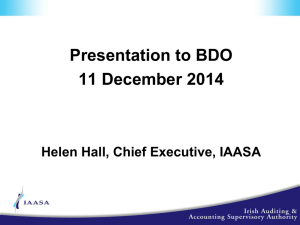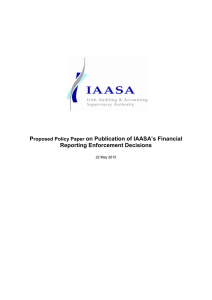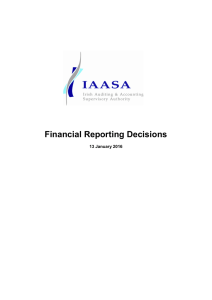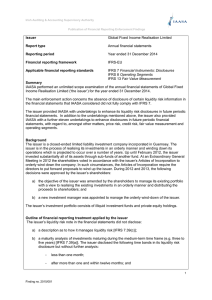of IAASA’s Financial Policy Paper on Publication Reporting Enforcement Findings
advertisement
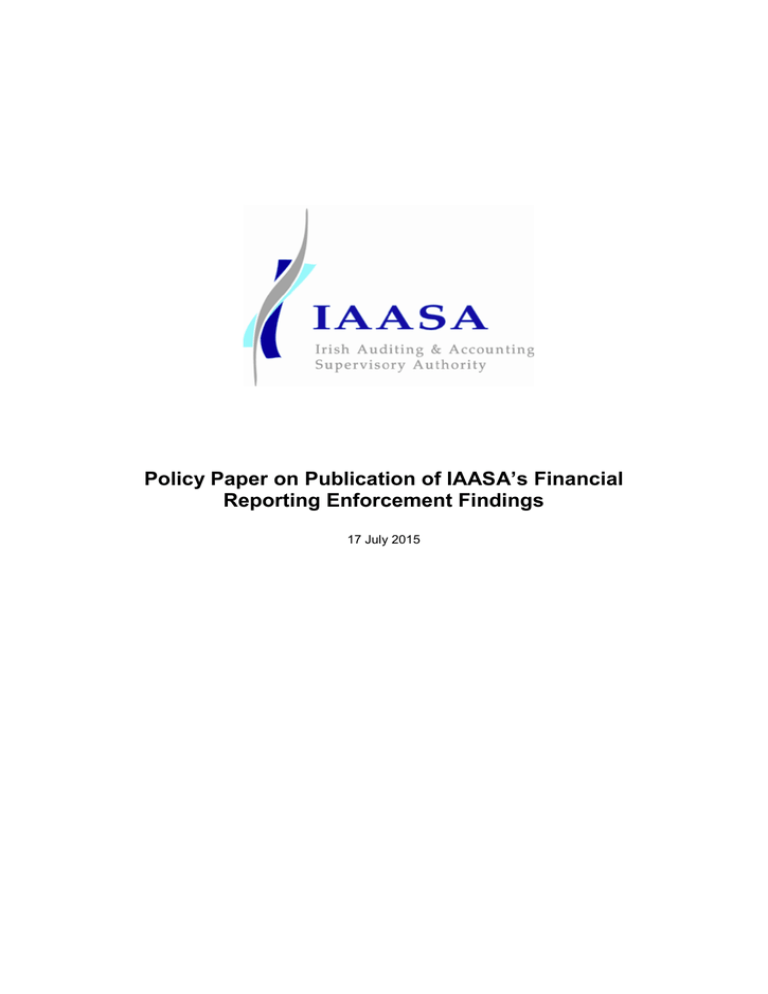
Policy Paper on Publication of IAASA’s Financial Reporting Enforcement Findings 17 July 2015 MISSION STATEMENT Our mission is to promote high quality financial reporting and effective regulation of accountants and auditors through the delivery of independent and effective supervision which protects the public interest TABLE OF CONTENTS Page 1. Purpose of this Paper 1 2. Background and context 1 3. Policy regarding publication of significant financial reporting enforcement findings 2 4. Nature of financial reporting enforcement information to be published 3 5. Other information likely to be published 4 6. Opportunity to comment – due process 5 APPENDIX – Legislative references 5–9 1. PURPOSE OF THIS PAPER On 4 February 2015, the Minister for Jobs, Enterprise and Innovation made the Transparency (Directive 2004/109/EC) (Amendment) Regulations 2015 (S.I. No. 44 of 2015) (‘the 2015 Regulations’) which came into operation on 9 February 2015. The effect of the 2015 Regulations is that the Irish Auditing and Accounting Supervisory Authority (‘IAASA’) is afforded a wider discretion in terms of publication of its financial reporting enforcement findings than heretofore. The purpose of this Paper is to set out IAASA’s policy on the publication of its financial reporting findings from the date the legislation came into effect. 2. BACKGROUND AND CONTEXT Previous confidentiality regime 1 As a result of various legislative constraints IAASA has operated under a very strict confidentiality regime regarding its financial reporting enforcement work. Providing information regarding its 2 activities and being transparent about the outcomes of examinations of issuers’ financial reports has been severely limited. As the legislation was worded, except in very restricted circumstances, IAASA was prohibited from disclosing information that it obtained in performing its functions or exercising its powers that had not otherwise come to the notice of members of the public. ESMA Guidelines on Enforcement of Financial Information (‘ESMA’s Enforcement Guidelines’) During 2014 ESMA (the European Securities and Markets Authority) issued its Guidelines on Enforcement of Financial Information. The objective of the Guidelines is to ensure that financial 3 information provided by issuers in accordance with the Transparency Directive complies with the applicable financial reporting framework. ESMA Enforcement Guideline 18 requires IAASA, to report periodically to the public on the enforcement activities at national level. In particular, IAASA is required to report periodically to the public on the enforcement policies adopted and decisions taken in individual cases including accounting and disclosure matters. Transparency (Directive 2004/109/EC) (Amendment) Regulations 2015 Regulation 2(d) of the 2015 Regulations amended the 2007 Regulations by inserting a new paragraph (3) into Regulation 43 as follows: “(3) IAASA may make public in such manner as IAASA considers appropriate, details of – (a) a requirement under paragraph (1)(a), (b) an administrative measure taken as a result of an examination of information by IAASA under Regulation 42(2) for the purpose of considering whether such information is in accordance with the relevant reporting framework, (c) an action taken by an issuer or director in response to an administrative measure taken as a result of an examination of information by IAASA under Regulation 42(2) for the purpose of considering whether such information is in accordance with the relevant reporting framework, (d) a notice given under Regulation 44, 1 Section 940 of the Companies Act 2014 [and, until 1 June 2015, Section 31 of the Companies (Auditing and Accounting) Act 2003] and Regulations 42, 43 and 77 of the Transparency (Directive 2004/109/EC) Regulations 2007 (as amended). The Appendix to this document sets out the text of selected legislation 2 IAASA’s financial reporting review remit extends to entities whose securities are admitted to trading on a regulated market, situated, or operating, within the European Union and whose home Member State is Ireland. [Regulation 2 of the Transparency (Directive 2004/109/EC) Regulations 2007 (S.I. No. 277 of 2007) (as amended by the Transparency (Directive 2004/109/EC) (Amendment) Regulations 2012 (S.I. No. 238 of 2012)) refers]. Such entities are referred to as “issuers” in this document 3 Directive 2004/109/EC of the European Parliament and of the Council of 15 December 2004 on the harmonisation of transparency requirements in relation to information about issuers whose securities are admitted to trading on a regulated market and amending Directive 2001/34/EC 1 (e) a direction given under Regulation 45, (f) a written explanation provided in accordance with Regulation 44, or (g) revised information prepared in accordance with Regulation 44 or 45.” Consultation Process IAASA sought the views of stakeholders and invited interested parties to provide their comments on 4 the proposed Policy Paper which was issued for consultation on 22 May 2015 . This document reflects, to the extent deemed appropriate, the comments received from those respondents. It is IAASA’s intention to periodically review the Policy and may amend the Policy based on experience gained from the publication of its financial reporting enforcement findings. 3. POLICY REGARDING SIGNIFICANT FINANCIAL REPORTING ENFORCEMENT FINDINGS Pursuant to its broadened powers under Regulation 43 of the 2007 Regulations, IAASA may publish significant financial reporting enforcement findings in accordance with section 43 of the 2007 Regulations, including “Action” decisions and “Non-action” decisions. Action decision An action decision is an outcome where IAASA concludes that the information drawn up pursuant to Regulations 4 to 8 of the 2007 Regulations by an issuer is, in a material respect, not in accordance with the relevant reporting framework. Where the information fails to comply with the relevant reporting framework, remediation – either on a voluntary basis by the issuer or by IAASA invoking its statutory powers – can take a number of forms. This may include an undertaking from the issuer’s directors to correct the failure to comply in future periodic financial statements with or without re-statement of comparative amounts, the issuance of a corrective notice by the issuer, or the issuance of an amended financial report by the issuer. Non-action decision A non-action decision is an outcome where IAASA concludes that the information drawn up pursuant to Regulations 4 to 8 of the 2007 Regulations by an issuer is: a) in all material respects in accordance with the relevant reporting framework, or b) while not apparently fully in accordance with the relevant reporting framework, is of such a nature that IAASA concludes that no further steps are required to be taken. In limited circumstances and where it is deemed appropriate, IAASA may on occasion publish the fact that it is undertaking a particular examination in advance of that examination being undertaken and in advance of any findings being made. Such prior announcement is intended to cover instances such as: a) thematic examinations where IAASA may announce the subject matter and the issuers selected for inclusion in advance of that examination being undertaken and in advance of any findings being made; and b) the examination of aspects of a specific issuer’s financial report in response to public concerns. In determining what constitutes a “significant” finding, IAASA has adapted the criteria set out in 5 ESMA’s Enforcement Guidelines . In that context, an IAASA financial reporting enforcement finding – 4 http://www.iaasa.ie/News/2015/IAASA-publishes-proposed-Policy-Paper-on-Publicati 2 including an action decision or a non-action decision – may be categorised as “significant” if it meets any of the following eight criteria. a) refers to financial reporting matters with technical merit; 6 b) has been discussed at EECS as an emerging issue; c) has been submitted to the EECS Decision Database; d) will be of interest to other European accounting enforcers; e) indicates to IAASA that there is a risk of significantly different financial reporting treatments being applied by issuers; f) is likely to have a significant impact on other Irish or European issuers; g) is taken on the basis of a provision not covered by a specific financial reporting standard; or h) otherwise meets IAASA’s mission of promoting high quality financial reporting. The ESMA Enforcement Guidelines cover financial statements prepared under IFRS. In instances where the finding relates to other aspects of the relevant reporting framework that falls within IAASA’s financial reporting enforcement activities an analogous criteria will be used. Examples include financial statements prepared under Irish GAAP or other sections of the annual report which are not prepared in accordance with IFRS such as the management report. Where IAASA forms the view that publication of a particular financial reporting enforcement finding would seriously jeopardise the financial markets or cause disproportionate damage to the parties 7 involved , it will take whatever steps are necessary in order to ensure that such consequences do not arise. Such steps may include omitting the name of the issuer concerned, redacting certain information from the publication, or refraining from publishing the finding at all. 4. NATURE OF FINANCIAL REPORTING ENFORCEMENT INFORMATION TO BE PUBLISHED The primary publication mechanism to be used by IAASA in publishing its financial reporting enforcement findings will be web releases on its website. This mechanism will ensure the outcome of IAASA’s financial reporting enforcement findings are made known on a timely basis to all stakeholders. In determining the nature of information to be published, IAASA will seek to achieve appropriate transparency for users of financial reports and a high level of investor protection. In applying these principles, IAASA will normally provide the following information when publishing financial reporting enforcement findings: a) name of issuer; b) type of financial report (i.e. annual financial statements or half-yearly financial report); c) reporting period; d) financial reporting framework adopted (e.g. IFRS, Irish and UK GAAP, other); 5 At Guideline 13 European Enforcers Coordination Sessions 7 Article 28.2 of Directive 2004/109/EC of the European Parliament and of the Council of 15 December 2004 on the harmonisation of transparency requirements in relation to information about issuers whose securities are admitted to trading on a regulated market and amending Directive 2001/34/EC refers 6 3 e) financial reporting standard(s) involved; f) outline of the financial reporting treatment applied by the issuer; g) outline of finding made by IAASA pursuant to Regulation 44 of the 2007 Regulations and the rationale for the finding; h) outline of the corrective actions, if any, undertaken or to be undertaken by the issuer on foot of the finding made by the Authority pursuant to Regulation 44. 5. OTHER INFORMATION LIKELY TO BE PUBLISHED While the primary publication mechanism to be used by IAASA in publishing its financial reporting enforcement activities will be web releases, listed below are the main other methods that will be used by IAASA to inform stakeholders about its financial reporting enforcement activity. 8 5.1 Annual Report IAASA’s annual report includes a chapter which outlines the key activities undertaken by IAASA in relation to its financial reporting enforcement function. It is expected that the results of individual examinations will be published and this may be on either an anonymous or a named basis. Any such identifying information will be published only in accordance with the policy outlined in this document. 5.2 Observations document In October/November each year IAASA publishes its Observations on Selected Financial Reporting 9 Issues . The purpose of this document is to assist issuers’ management and those charged with issuers’ governance in the preparation of high quality financial reports by offering observations on selected financial reporting issues to coincide with the preparation of issuers’ forthcoming financial statements. It is also sets out some of the matters which will be the focus of IAASA’s examinations when examining issuers’ financial reports. Certain matters included in the Observations document result from the financial reporting matters identified during IAASA’s examinations and surveys undertaken. While it is not intended to name specific issuers in future Observations documents, it may be the case that individual issuers could be identified from the matter being dealt with in the Observations document. Any such identifying information will be published only in accordance with the policy outlined in this document. 10 5.3 Thematic studies and surveys IAASA conducts thematic studies and surveys that focus on a particular financial reporting subject. These are normally published and are based on a desk-top review of a number of issuers. The purpose of the publications is to normally identify and describe common practice. In some instances good practice will be highlighted and in other occasions key recommendations will be made which, if applied, should enhance users’ understanding of the performance, financial position and cash flows and enable better comparability across issuers. The names of the issuers included in such thematic studies and surveys will be provided and details of the findings may also be published. Any such identifying information will be published only in accordance with the policy outlined in this document. 11 5.4 Information notes During the course of its financial reporting review activity, IAASA has, on occasion, identified a number of instances where an aspect of a financial reporting standard is not being complied with in full. The purpose of Information Notes is therefore, to draw appropriate attention to the requirements applying in a particular circumstance and, thereby assisting Directors to ensure compliance with the requirements. While it is not expected to name issuers in non-compliance in these Information Notes, it may be the case that they are named in other publications. 8 Available at http://www.iaasa.ie/Publications/General Available at http://www.iaasa.ie/Publications/FRSU 10 Available at http://www.iaasa.ie/Publications/FRSU 11 Available at http://www.iaasa.ie/Publications/FRSU 9 4 6. OPPORTUNITY TO COMMENT – DUE PROCESS Where the publication of a finding in line with Section 4 above is contemplated as a matter of courtesy, IAASA will provide the proposed wording to the issuer(s) in advance of publication for the purpose of informing the affected parties and / or providing to an opportunity to highlight any factual errors. IAASA will also consider on a case-by-case basis whether, in its opinion, it is appropriate to provide the proposed wording in advance to the statutory auditor. In such cases, the affected party will be provided with an opportunity to comment on the draft but the final decision on the nature, extent and wording of reporting will remain with IAASA. 5 APPENDIX – LEGISLATIVE REFERENCES Text of Regulation 43(1) of the Transparency (Directive 2004/109/EC) Regulations 2007 (as amended by Regulation 2 of the Transparency (Directive 2004/109/EC) (Amendment) Regulations 2015) 43. (1) Without prejudice to the generality of Regulation 42, IAASA shall, in particular, have the power to: (a) require any of the following persons to produce any document in his or her possession or control and to make copies of such documents, or to provide any information or explanations that it may reasonably require, for the purpose of examining and reviewing information published pursuant to Regulations 4 to 8: (i) an issuer; (ii) any director, manager, officer or employee of an issuer; (iii) any persons who control or are controlled by a person referred to in clause (i) or (ii); (iv) any person discharging managerial responsibilities of the issuer; (v) an auditor of an issuer; (vi) any person who fell within any of clauses (i) to (v) at a time when the document or information required by IAASA was prepared or came into existence; and (b) certify to the Court the refusal or failure of any person referred to in any of clauses (i) to (v) of subparagraph (a) to comply with a requirement made by IAASA pursuant to that subparagraph. (2) The disclosure to IAASA by an auditor of any information, document, fact or decision on foot of a requirement made by IAASA under paragraph (1)(a) shall not be regarded as constituting a breach of any restriction on disclosure of information imposed by contract or by any law, regulation or administrative provision and shall not involve the auditor in liability of any kind. (3) [Inserted by Regulation 2 of the Transparency (Directive 2004/109/EC) (Amendment) Regulations 2015)] IAASA may make public in such manner as IAASA considers appropriate, details of – (a) a requirement under paragraph (1)(a), (b) an administrative measure taken as a result of an examination of information by IAASA under Regulation 42(2) for the purpose of considering whether such information is in accordance with the relevant reporting framework, (c) an action taken by an issuer or director in response to an administrative measure taken as a result of an examination of information by IAASA under Regulation 42(2) for the purpose of considering whether such information is in accordance with the relevant reporting framework, (d) a notice given under Regulation 44, (e) a direction given under Regulation 45, (f) a written explanation provided in accordance with Regulation 44, or (g) (g) revised information prepared in accordance with Regulation 44 or 45. 6 Text of Regulation 75 of the Transparency (Directive 2004/109/EC) Regulations 2007 75 (1) The Bank and IAASA shall each – (a) co-operate with the competent authorities of other Member States, designated under the Directive, whenever necessary, for the purpose of the performance by each of the competent authorities of the Member States (including the Bank or IAASA, as appropriate) of their functions and the making use of their powers (whether set out in the Directive, transparency (regulated markets)law or the measure for the time being adopted by another Member State to implement the Directive), and (b) render assistance to competent authorities of other Member States in the performance of their functions (whether set out in the Directive or the measures for the time being adopted by another Member State to implement the Directive). (2) In particular and without prejudice to its obligations under section 33AK(10) of the Central Bank Act 1942, as amended, or section 31 of the Companies (Auditing and Accounting) Act 2003, as the case may be, nothing in any law shall prevent the Bank or IAASA from exchanging confidential information. Information thus exchanged shall be covered by the obligation of professional secrecy to which the persons employed or formerly employed by the competent authorities receiving the information are subject. (3) The Bank or IAASA may conclude, for their respective purposes, cooperation agreements with the competent authorities or bodies of third countries enabled by their respective legislation providing for the exchange of information so as to allow the carrying out of any of the tasks assigned by the Directive to the competent authorities in accordance with Article 24 of the Directive. (4) Such an exchange of information – (5) (a) is subject to the authority with whom the information is exchanged guaranteeing that a level of professional secrecy at least equivalent to that referred to in Article 25 of the Directive shall apply to the information, and (b) shall be intended for the performance of the supervisory task of the authorities or bodies mentioned in paragraph (3). Without prejudice to paragraph (4), where the information proposed to be exchanged originates in another Member State – (a) it shall not be exchanged without the express consent of the competent authority which disclosed it in the first place, and (b) if the purpose for which it was so disclosed was limited to any extent specified in that consent, shall be exchanged only for the purpose so specified. 7 Text of Regulation 76 of the Transparency (Directive 2004/109/EC) Regulations 2007 76 (1) If the contravention in respect of which a person is convicted of an offence under another provision of this Regulation is continued after the conviction, the person shall be guilty of a further offence on every day on which the contravention continues. (2) Where any offence is committed under another provision of this Regulation by a body corporate and is proved to have been committed with the consent, connivance or approval of or to have been attributable to the willful neglect on the part of any person, being a director, manager, secretary or other officer of the body corporate or a person who was purporting to act in any such capacity, that person as well as the body corporate shall be guilty of an offence and is liable to be proceeded against and punished as if he or she was guilty of the first mentioned offence. (3) A person who contravenes Regulation 54(6) or 73 shall be guilty of an offence. (4) A person who, knowing the information to be so false or misleading, or being reckless as to whether or not it is so false or misleading, discloses information in purported compliance with a requirement imposed on the person by or pursuant to these Regulations which is false or misleading in a material respect shall be guilty of an offence. (5) A person who is guilty of – an offence under this Regulation other than an offence referred to in subparagraph (b), or one or more further offences under paragraph (1), for each such offence, shall be liable on summary conviction to a fine not exceeding €5,000 or imprisonment for a term not exceeding 12 months or both. (6) Every offence under this Regulation is an offence to which section 21 (penalties on indictment) of the Investment Funds, Companies and Miscellaneous Provisions Act 2006 applies. 8 Section 31 of the Companies (Auditing and Accounting) Act 2003 (as amended by Regulation 53 of the European Communities (Statutory Audits) (Directive 2006/43/EC) Regulations 2010 and as amended by Section 15(b) of the Central Bank Reform Act 2010) Section 31 of the Companies (Auditing and Accounting) Act 2003 has been repealed and replaced by Section 940 of the Companies Act 2014 from 1 June 2015. 31 (1) No person shall disclose, except in accordance with law, information that – (a) is obtained in performing the functions or exercising the powers of the Supervisory Authority, and (b) has not otherwise come to the notice of members of the public. (2) Without limiting subsection (1), the persons to whom that subsection applies include the following: (a) a member or director or former member or director of the Supervisory Authority; (b) an employee or former employee of the Supervisory Authority; (c) a professional or other adviser to the Supervisory Authority, including a former adviser. (3) Subsection (1) does not prohibit the Supervisory Authority from disclosing information referred to in that subsection – (a) if the disclosure is, in its opinion, necessary to enable it to state the grounds on which it made a decision under section 23, 24 or 26, (b) if the information is, in its opinion, connected with the functions of, and if the disclosure is made to, any of the following: (i) (ii) (iii) (iv) (v) (vi) (vii) (viii) (ix) (x) (xi) (xii) (xiii) (xiv) (xv) the Minister; the Minister for Finance; the Garda Sıochana; the Director of Public Prosecutions; the Director of Corporate Enforcement; the Revenue Commissioners; the Comptroller and Auditor General; the Central Bank of Ireland; the Irish Takeover Panel; the Irish Stock Exchange; the Pensions Board; a prescribed accountancy body; a member of a recognised accountancy body who is qualified for appointment as an auditor; an inspector appointed under any other enactment; any person prescribed under section 48(1)(i) for the purposes of this section, or (c) if the information disclosed is to an individual or entity performing functions in another state which are similar to the functions the Authority has by virtue of the European Communities (Statutory Audits) (Directive 2006/43/EC) Regulations 2010 (including functions under this Act which the Authority has by virtue of those Regulations), provided that restrictions equivalent to those provided by this section apply in that state in relation to that individual or entity with respect to disclosure of information so given. (4) A person who contravenes subsection (1) is guilty of an offence. 9 Section 940 of the Companies Act 2014 Section 31 of the Companies (Auditing and Accounting) Act 2003 has been repealed and replaced by Section 940 of the Companies Act 2014 from 1 June 2015 940. (1) (2) A person shall not disclose information that – (a) comes into the possession of the Supervisory Authority by virtue of the performance by it of any of its functions under this Act; and (b) has not otherwise come to the notice of members of the public. Subsection (1) shall not apply to – (a) person specified in subsection (3) or a director of the Authority in the performance by the Authority, or him or her, of any of its or his or her functions under this Act or any other enactment, being a communication the making of which was, in the Authority’s or his or her opinion, appropriate for the performance of the function concerned; or (b) the disclosure of information in a report of the Supervisory Authority or for the purpose of any legal proceedings, investigation, enquiry or review under this Act or any other enactment or pursuant to an order of a court of competent jurisdiction for the purposes of any proceedings in that court; or (c) a disclosure made where such disclosure is required by, or in accordance with, law; or (d) a disclosure of information which, in the opinion of the Supervisory Authority, a member of its staff, any person specified in subsection (3) or a director of the Authority, may relate to the commission of an offence; or (e) a disclosure to a person prescribed by regulations made by the Supervisory Authority as a person to whom a disclosure, or a specified class of disclosure, may lawfully be made. (3) The persons mentioned in subsection (2)(a) and (d) are any agent of the Supervisory Authority or professional or other adviser to it. (4) A person who contravenes subsection (1) shall be guilty of a category 2 offence. 10
